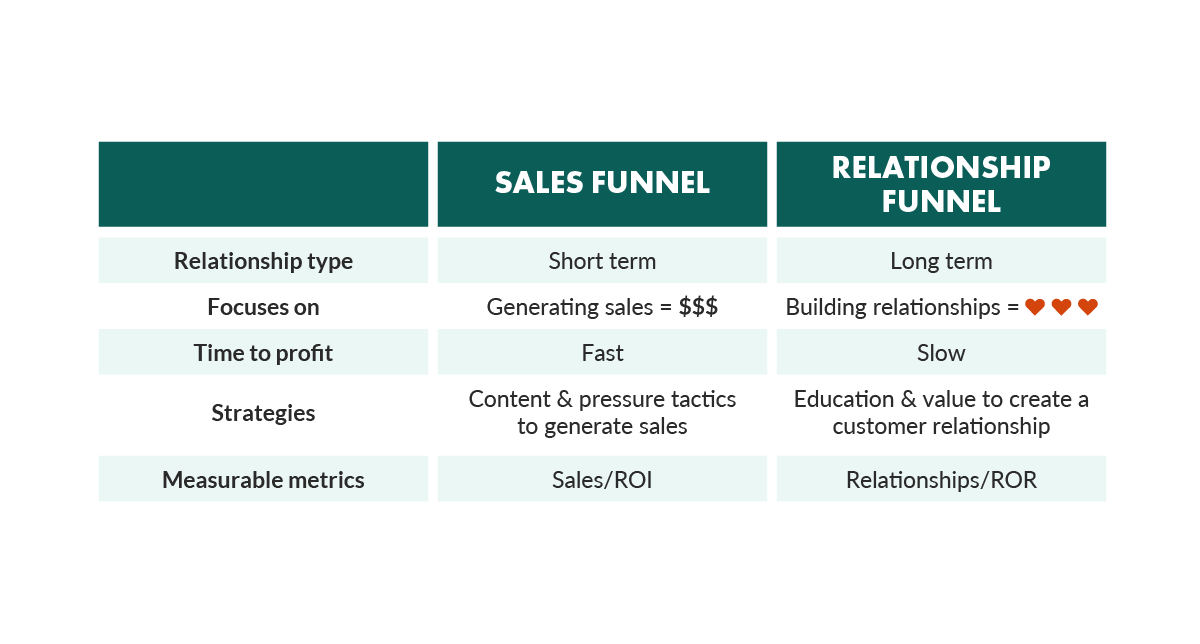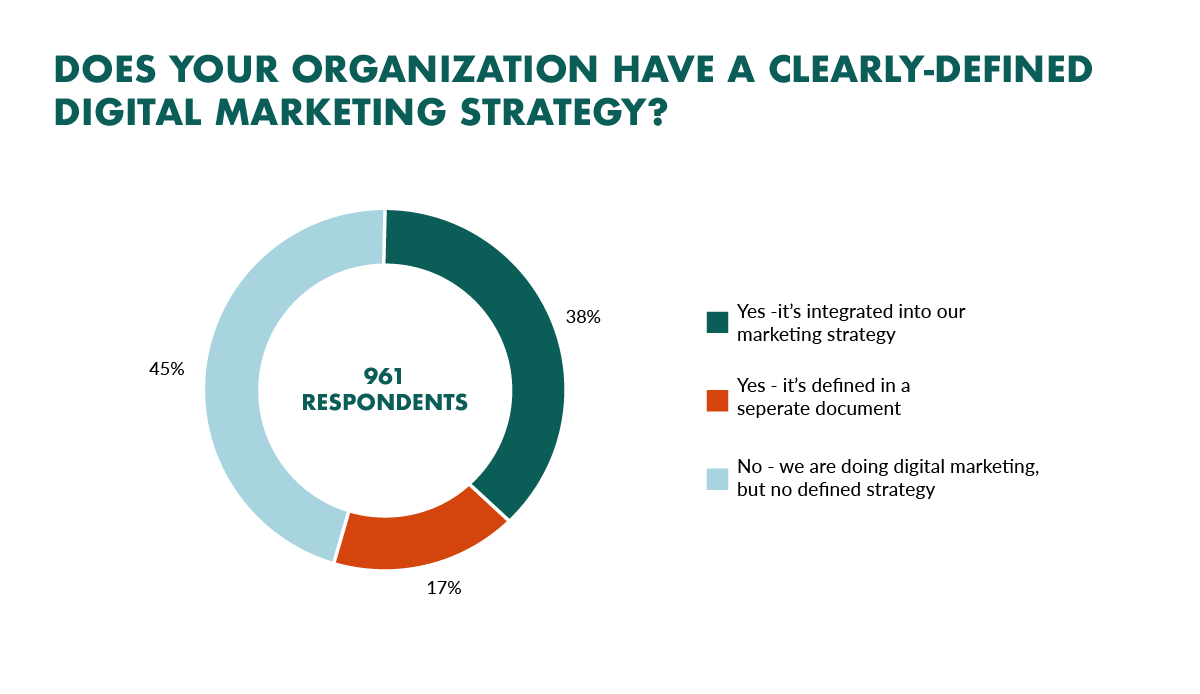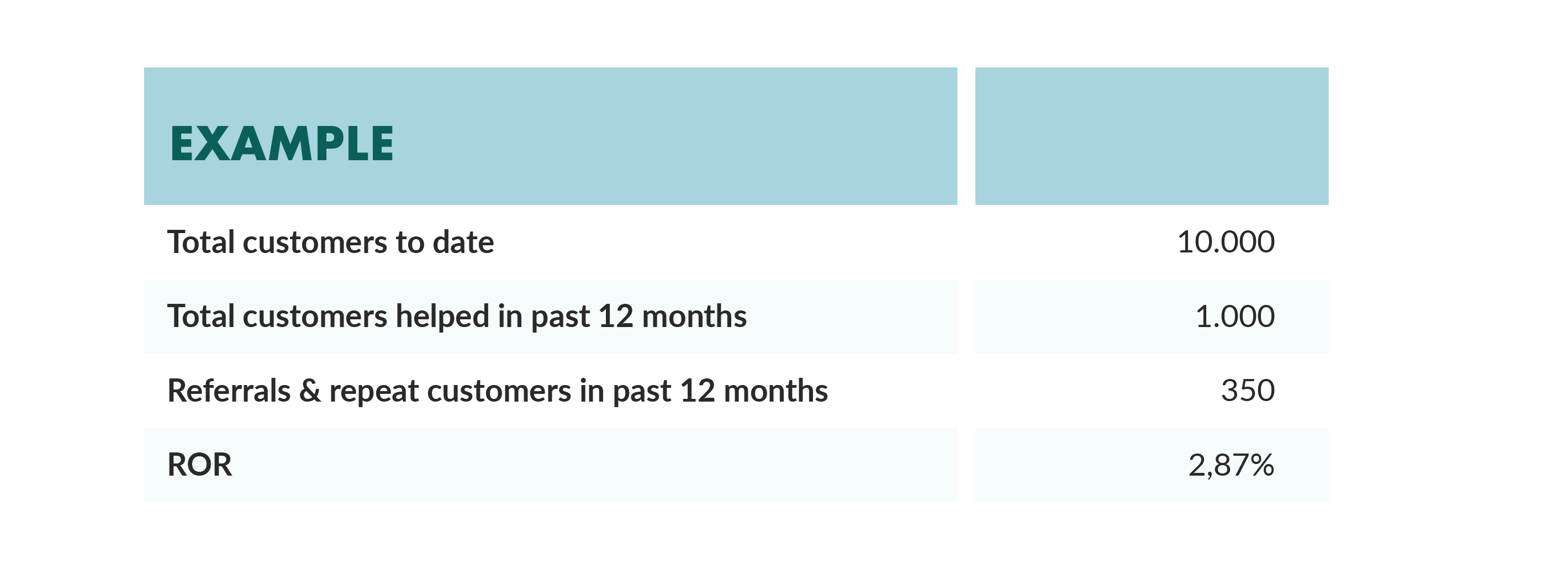Customers are the backbone of every business.
However, before any person becomes a customer, they start by going on a journey through various touchpoints, channels, and experiences with your business.
Whether you’re an e-commerce company or in B2B sales, there are two powerful strategies to earn their trust, maintain their confidence, and win their loyalty.
Those are: sales funnels and relationship funnels.
Today, we'll explore them both and, more importantly, what makes them different.
How are sales and relationship funnels different?
You might think that a sales funnel and a relationship funnel are the same. Both aim to attract and convert customers.
But that’s not the case.
While, traditional sales funnels use psychology tactics to pressure and pull people into buying, without little to no consideration of their interests or needs. A relationship funnel is intended to build long-term business relationships that reflect the customers’ real needs.
Another difference is that relationship funnels are designed to provide a seamless, positive customer experience throughout every touchpoint. Since experience is the foundation of a relationship funnel, customers feel more of an emotional connection which can increase lifetime value by 300% and improve the likelihood of recommending your business to others.
Since experience is the foundation of a relationship funnel, customers feel more of an emotional connection which can increase lifetime value by 300% and improve the likelihood of recommending your business to others.
Let’s explore both sales funnels and relationship funnels in more depth to see what’s the best one for your business.
What’s a sales funnel?
A sales funnel is a visualization of a multi-step process that moves prospects into buyers.
There are multiple steps because it takes time for a prospective buyer to become aware of your business to the moment they decide to purchase.
Depending on your industry, the number of stages and the length of the sales cycle may vary. However, the goal is the same: to visualize the pathway to attract leads and convert them into paying customers.
Let’s take a quick look at a typical sales funnel and how it works:
Awareness
This is the moment when a customer discovers your business. They may already be aware of their problems and the possible ways to solve it.
Customers may first encounter your business through Google ads, search results, a post shared on social media, or word of mouth.
Interest
At this stage in the funnel, customers are signing up for newsletters, submitting forms for webinars, and reaching out to learn more. Meaning, they perform actions that mostly trigger marketing.
Unfortunately, 45% of organizations don’t have a clearly defined strategy for their digital marketing efforts. Without a strategy or a clear understanding of your customer's needs, this can make or break your sales funnel's effectiveness.

One of the ways to encourage people to move further down the funnel is to create customer profiles.
By documenting and outlining your customer’s key demographics, interests, and behaviors, you can better address their individual needs in a way that captures their interest.
Decision
If a customer has an interest in your business, they are beginning to form a decision as to whether they should buy from you or not.
Some questions they may be considering are:
- “Does [your company] provide better customer support than [your competitor]?”
- “Who has the best and most relevant features for my needs?”
- “What are the contract terms with [your company] versus [your competitor]?”
If you are collecting customer data throughout their journey in your sales funnel, your sales and support teams will be able to handle any questions and objections with ease.
There are many ways to collect the behavioral customer data that help you know your customers better. One of which, for example, is LeadExplorer.
LeadExplorer gives you insights every time a customer visits your website. This information can help you craft emails or prepare for a sales meeting that better addresses their needs and move them one step closer to a sale.
Action
Making a purchase is a natural conclusion of the previous three steps. By now, your new customer is familiar with your business, they know how you can solve their problem, they investigated other options and decided that you were the best fit for their business.
In more advanced sales funnels you may see additional steps (to these 4) that include upselling, retention strategies, and loyalty programs.
Why should you use a sales funnel?
According to Hubspot's' 2020 State of Marketing Report, the top priority for marketers in 2021 is “generating leads.”
With a well-crafted sales funnel, you can create a powerful strategy that attracts new customers.
And to improve your chances of attracting and converting customers, here are a few things to keep in mind:
- Most customers need to hear company claims 3 to 5 times before they believe it.
- Companies that make buying easy are 62% more likely to win a high-quality sale.
- 95% of customers choose a company that provides them with sufficient content to help them navigate each stage of the buying process.
However, a sales funnel is not the only strategy out there that helps you boost your sales.
Enter, the relationship funnel.
What’s a relationship funnel?
Customers are looking for companies they can trust.
While psychological triggers like scarcity and discounts can attract new customers in the short-term, it does not guarantee that a customer will stick around for the long-term.
According to Gartner, customers want to be more than “just another number” and expect companies to treat them as if they were special.
If you want long-term relationships, repeat purchases, and customer loyalty – you need a relationship funnel. Why?
Because relationship-based growth is focused on relationships that drive key business results, scale sales and support, and increase marketing’s effectiveness.
Here’s a quick overview of a relationship funnel and how it works:

Building relationships
In today’s world, customer relationships are built using a variety of activities, strategies, and digital technologies.
Companies are required to adopt new methods and adapt their business practices to meet customer expectations.
According to Salesforce, customers expect:
- Companies to provide new products/services more frequently than ever before;
- Contextualized and tailored engagement based on past interactions;
- Connected journeys with seamless transitions between channels.
Companies with high performing sales use a formal, guided sales process.
This is similar to the customer journey, except it provides a step-by-step roadmap that guides your salespeople towards:
- Understanding where your customers are;
- When it’s time to move to the next step;
- And, how to adjust their course if faced with objections.
The key is to focus on the way customers want to buy instead of the way your business wants to sell to create a frictionless buying experience. It's 100% buyer-centric.
It’s important to note here that while your company’s features and benefits are important, they are not enough to win every customer.
Nurturing relationships
Customers come and go – that is the natural life cycle of every business.
However, customers that come and customers that stay are known to be far more profitable.
- The cost of acquiring a new customer can be five times more than retaining an existing customer (Harvard)
- Increasing customer retention by 5% can increase profits between 25 to 95% (Invesp Consulting)
- Chance of selling to an existing customer is 60-70%, while selling to a new customer is 5-20% (Marketing Metrics)
As customers flow into your sales pipeline, having an effective nurturing strategy can enhance relationships. Nurturing relationships should serve mutually beneficial exchanges (meaning, giving away something to add value, develop skills, or increase opportunities) without any sales intent.
Easier said than done, right?
When SuperOffice moved upmarket, one of our strategies was to reevaluate the content we delivered.
By shifting from top-of-funnel to highly targeted, mid-to-lower level content we started providing more relevant and meaningful content that helped current and future customers.
Another way to nurture relationships is through email marketing.
Even though communication methods are continually evolving, as seen with mobile devices and social media, email marketing remains an effective channel for nurturing leads and generating sales.
- 80% of business professionals believe that email marketing increases customer retention.
- 59% of respondents say marketing emails influence their purchase decisions.
- Segmented campaigns can see as much as a 760% increase in sales.
Ultimately, focusing on the needs of a customer, especially through segmentation and personalization, can solidify trust and maintain relationships into the future.
Relational experience
Customers are seeking experiences that make them feel connected to the companies that win their business. To prevent them from leaving and considering a competitor, personalization can keep customers longer throughout a customer's journey.
- 44% of consumers say they will buy again after a personalized shopping experience.
- 40% of people are more likely to spend more than planned as a result of personalization.
- 63% of smartphone users are more likely to purchase from companies that offer relevant recommendations on products based on their interests.
According to CallMiner’s Churn Index 2020 Report, customers want to stay loyal to companies. However, poor service and annoying automated experiences are two driving factors that force a customer to switch to another business.
This is why it’s important to create a positive experience at every touchpoint to encourage customers to continue doing business with you.
What can you do to ensure your customers are getting an experience that keeps them for the long term?
- Align your customer profiles with their customer journey.
- Update processes to serve more qualified customers.
- Provide steps and milestones that guide your teams on how to engage with customers.
- Identify and improve experiences throughout critical stages in your sales pipeline.
Having a CRM also helps to acquire and analyze insights in order to align your team toward a seamless customer experience with your business.
Relational performance
While ROI is traditionally used to evaluate a sales funnel's profitability, the relationship funnel focuses on the return on relationship.
This idea is coined by Ted Rubin, who says:
"RoR (Return on Relationship) is the value accrued by a person or a brand due to nurturing a relationship. ROI (Return on Investment) is simple dollars and cents. RoR is the value (perceived and real) that will accrue over time through loyalty, recommendations, and sharing."
Calculating ROR doesn’t require complex analytics. Instead, you can use a simple formula to determine how successful your business is at generating referrals or repeat business.
Use this simple table to calculate your ROR.

With customer relationship management, you gain a 360-degree view of your customer’s insights. From here, you can find a mix of tangible numbers and the outcome of relational efforts that drive customer engagement, loyalty, and referrals.
Why should you use a relationship funnel?
Relationship funnels focus on building long-term relationships with customers and work better to satisfy customer expectations.
How?
Instead of focusing on selling, you put a customer's needs first and establish trust to achieve optimal results.
Since business is a network of relationships, it makes sense to invest in strategies that:
- Build relationships based on a connected customer journey,
- Nurture relationships throughout critical phases and touchpoints,
- Deliver experiences that lead to long-lasting relationships and customer loyalty,
- Track relationship-based strategies to evaluate performance and enhance future efforts.
No matter what industry you operate in, relationship building is the key for winning new business from new and existing customers. As you focus on nurturing the needs of your customers, remember that the mutual benefits you provide will go a long way to accelerate the growth of your company.
Which funnel is right for your business?
Put simply: People do not want you to sell them something.
Instead, they want to have a relationship with mutual benefits that continually addresses ongoing concerns and needs.
So, which funnel is best for you? Well, the choice is yours.
Are you going to be the business that focuses on relationships while providing a customer experience that inspires trust and loyalty?
I know we are.
If you'd like to receive new strategies for how to improve the customer experience, create long-term relationships, and grow your business, then sign up to Thrive below.




